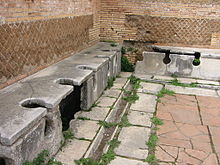This is an old revision of this page, as edited by Altenmann (talk | contribs) at 02:04, 7 October 2005 (OK then. This is one of your suggested compromises; this section is even more relevant for placing an image). The present address (URL) is a permanent link to this revision, which may differ significantly from the current revision.
Revision as of 02:04, 7 October 2005 by Altenmann (talk | contribs) (OK then. This is one of your suggested compromises; this section is even more relevant for placing an image)(diff) ← Previous revision | Latest revision (diff) | Newer revision → (diff)Template:Subarticleof Human feces vary significantly in appearance, depending on the state of the whole digestive system, influenced by diet and health. Normally they are semisolid, with mucus coating. Small pieces of harder, less moist feces can be seen impacted on the distal end (a normal occurrence when a prior bowel movement is incomplete, and feces is returned from the rectum to the intestine, where water is absorbed.)
Meconium (sometimes erroneously spelled merconium) is a newborn baby's first feces.
Due to its taboo, feces are a subject of toilet humor.
Feces disposal

Main articles: Toilet, Latrine, Sewage.
The problem of efficient feces disposal existed since the times when people started to live in permanent settlements, primarily for the reasons of cleanness and odor. Toilets were known in ancient India (dated as early as 2,500 BCE), in Ancient Rome, Egypt and China.
Over the time it has become clear that the disposal of feces is an issue of hygiene, since feces contribute to spreading of diseases and intestinal parasites. It is a matter of attention and education in developing countries.
Until about the end of 19th century, the primary concern of sewage collection and disposal was to remove waste away from inhabited places, and it was common to use waterflows and larger bodies of water as a destination of sewage, where waste could be naturally dissipated and neutralized. With the increased population density this is no longer a viable solution, and special processing of sewage is required. The lack of the latter is a grave sanitary problem in developing countries.
Tourism

Nature reserve organizations, parks, and tourist agencies often issue regulations for tourists aimed at the prevention of the pollution of the nature. In particular, catholes (cat holes), i.e., pits for feces, must be located at a resonable distance (at least 200 feet) from water sources (rivers, lakes, etc.), to avoid possible bacterial contamination of water via precipitation, as well as away from trails. For faster feces decomposition, organic soil is preferred for a mineral (sandy) one. It is also recommended to avoid concentration of catholes around campsites. Filled catholes must be covered with a reasonably thick layer of soil, to prevent access by animals, some of which are coprophagous.
Some areas require special instructions on human waste disposal. In rocky places, with the absence of soil, it is advised to spread feces thinly by smearing over rocks with good sun access for faster sterilization by UV radiation and drying. In larger snow fields, a larger distance (e.g., 200 yards) from trails and campsites may be mandated, if the waste is being disposed under snow.
Laboratory testing of feces

In the medical profession, feces are referred to as stools. This comes from the Anglo-Saxon word stol, which means "seat". The word stool was originally used to describe the seat one sat on to defecate. So, an euphemism was that they were "going to stool." By the end of the 16th century, the word stool was used to mean the same thing as feces.
Feces will usually be required for microbiological testing, looking for an intestinal pathogen.
Biochemical tests done on feces include fecal elastase and fecal fat measurements, as well as tests for fecal occult blood.
It is recommended that the clinician correlate the symptoms and submit specimens according to laboratory guidelines to obtain results that are clinically significant. Formed stools often do not give satisfactory results and suggest little of actual pathologic conditions.
Three main types of microbiological tests are commonly done on feces:
- Antibody-antigen type tests, that look for a specific virus (e.g. rotavirus).
- Microscopic examination for intestinal parasites and their ova (eggs).
- Routine culture.
Routine culture involves streaking the sample onto agar plates containing special additives, such as MacConkey's Agar, that will inhibit the growth of Gram-positive organisms and will selectively allow enteric pathogens to grow, and incubating them for a period, and observing the bacterial colonies that have grown.
Yellowing of feces can be caused by an infection known as giardia. Giardia are tiny parasitic organisms. If giardia infects the intestines it can cause severe yellow diarrhea. This is a dangerous communicable infection and must be reported.
Another cause of yellowing is a condition known as Gilbert's Syndrome. This condition is characterized by jaundice and hyperbilirubinemia. Hyperbilirubinemia occurs when too much bilirubin is present in the circulating blood.
Feces can be black if dried blood is present in them from a bleed. More active bleeding can lead feces to be red in color, signaling a need for medical attention.
In children with certain illnesses, feces can be blue or green. Babies also produce green feces when they are given food for the first time.
The main pathogens that are commonly looked for in feces include:
- Salmonella and Shigella
- Yersinia (this tends to be incubated at 30 °C, which is cooler than usual.)
- Campylobacter (incubated at 42 °C, in a special environment.)
- Aeromonas
- Candida (if the person is immunosuppressed e.g. cancer treatment.)
- E. coli O157 (if blood is visible in the stool sample.)
See also
External link
- Sanitation. Instructions for Olympic National Park.